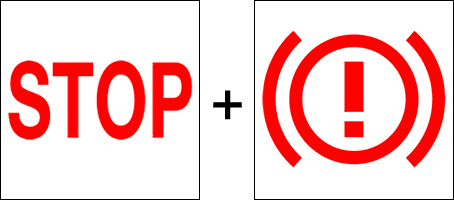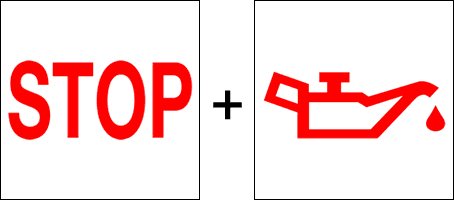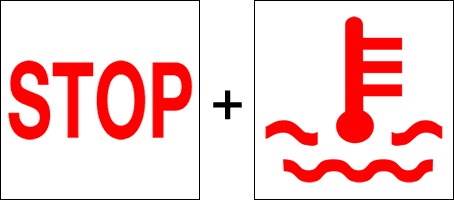STOP Dashboard Warning Light Explained
Certain vehicle manufacturers make use of the red STOP warning light. The stop warning light may illuminate alone, or come on with another warning light, an audible alert and a on-screen text message.
What Should You Do if the Stop Warning Light Comes on?
As the warning light suggests, you should stop your vehicle as soon as it’s safely possible. Observe traffic conditions and when safe to do so, pull off the road, secure the vehicle using the parking brake and switch off the engine.
If you have a mechanic / vehicle service repair workshop that you use, contact them or your vehicle manufacturer’s dealership. You may need to contact a vehicle breakdown service to have your car towed.
What Does the Stop Warning Light Mean?
The stop warning light means that a serious fault has occurred and that the engine may cut out and/or there may be a risk to the safety of the vehicle occupants. The stop warning light is typically associated with the following faults:
- Vehicle braking system
- Power steering
- Engine lubrication system
- Engine cooling system
If the stop warning light illuminates independently without any other warning lights, it means a serious fault has been detected but that does not have a warning light assigned to it. In this situation, it’s recommended that you have your vehicle towed to a safe location. In order to locate the problem, diagnostic equipment will be required to read any fault codes that may be generated and stored.
Vehicle Braking System
If the stop warning light comes on along with the brake warning light, it means a serious problem with the braking system has been detected. This may be due to low brake fluid. Check brake fluid levels and top up using the manufacturer’s recommended fluids.

This may resolve the issue. However, if brake fluid levels continues to fall, it may indicate a leak in the system, particularly if the brake pedal feels spongy and the brakes unresponsive.
Other issues may include problems with the brake booster (a device that aids the driver in applying brake pressure when pressing the pedal). A failure with the brake booster means that it requires greater force than usual when pressing the brake pedal, to achieve the same results.
It may also be a problem with the vehicle’s Electronic Brakeforce Distribution (EBD). When pressing the brake pedal, EBD applies greater or lesser brakeforce to independent wheels. The benefit of EBD is that is can help to reduce stopping distances. A failure with EBD can result in unpredictable braking, or the brakes locking up.
Power Steering
If the stop warning light comes on along with the red power steering warning light, it means that a total failure of the power steering system has been detected. The reasons for power steering failure depend on the type of power steering in your car.

If you have hydraulic power steering, there may be a leak in the system causing low levels of hydraulic fluid. If you have electronic power steering, you may see a EPS warning light and you’ll not have any hydraulic fluid. EPS usually fails due to battery issues.
The lack of power steering will result in the car significantly harder to steer, particularly at slow speeds. Due to the car being more difficult to steer, there’s a risk of collision, hence the stop warning light.
Engine Lubrication System
A problem with the engine lubrication system means that engine oil may not properly lubricate all engine components, which can result in excess heat and ultimately engine seizure.

A lack of engine lubrication is often due to low engine pressure which can sometimes be due to low engine oil levels. If the stop warning light and the low oil pressure light come on, safely stop your vehicle and switch off the engine.
Check engine oil levels and add oil if required. Check that the stop light and oil light have gone off. If the lights remain on, do not drive the vehicle as it’ll result in significant engine damage.
Engine Cooling System
The stop warning light along with the engine coolant warning light coming on means that the engine is overheating. You must stop the car and switch off the engine to prevent damage.

Allow at least 20 minutes or more for the engine to cool. Then, check coolant levels and ensure the cooling fan and belts are operating. A significant loss of coolant may indicate a leak in the system. Temporarily, you can use normal water in the cooling system for emergencies, but once able, you must drain the system and replace with the correct coolant mixture.
